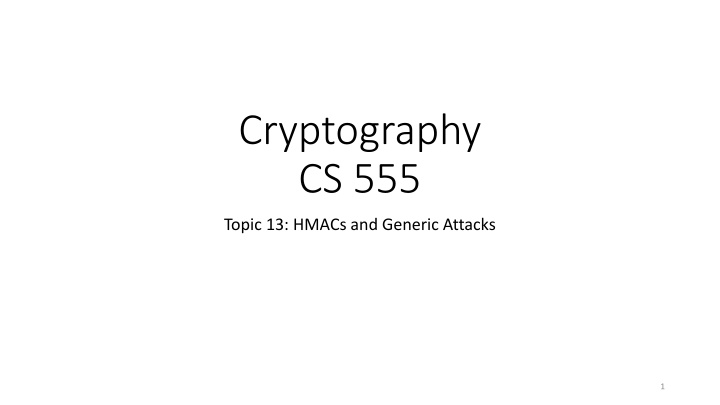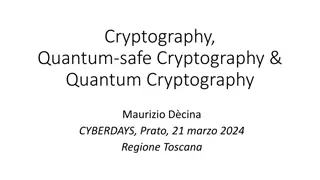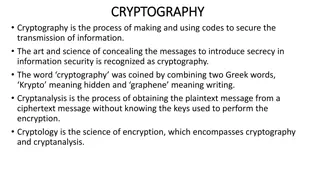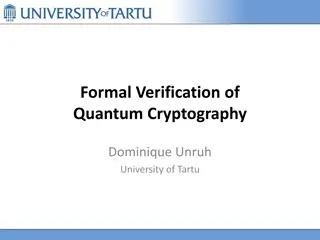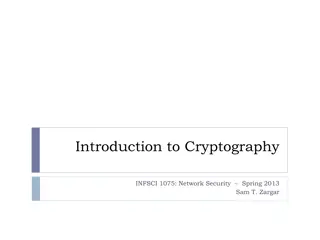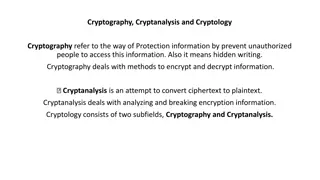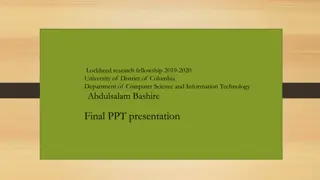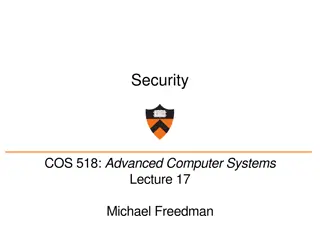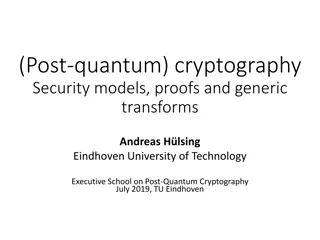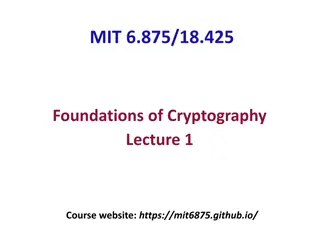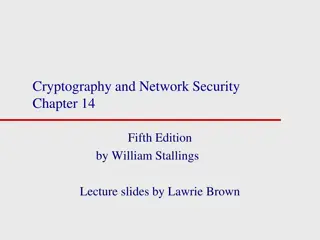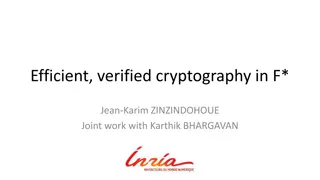Cryptography CS 555
This topic delves into HMACs (Hash-based Message Authentication Codes) and generic attacks within the realm of cryptography. It explores the use of HMACs as a tool for verifying the integrity and authenticity of messages, while also addressing potential vulnerabilities through discussions on generic attacks. Understanding these key concepts is crucial for ensuring secure communication and data protection in various systems.
Download Presentation

Please find below an Image/Link to download the presentation.
The content on the website is provided AS IS for your information and personal use only. It may not be sold, licensed, or shared on other websites without obtaining consent from the author.If you encounter any issues during the download, it is possible that the publisher has removed the file from their server.
You are allowed to download the files provided on this website for personal or commercial use, subject to the condition that they are used lawfully. All files are the property of their respective owners.
The content on the website is provided AS IS for your information and personal use only. It may not be sold, licensed, or shared on other websites without obtaining consent from the author.
E N D
Presentation Transcript
Cryptography CS 555 Topic 13: HMACs and Generic Attacks 1
Recap Cryptographic Hash Functions Merkle-Damg rd Transform Today s Goals: HMACs (constructing MACs from collision-resistant hash functions) Generic Attacks on Hash functions 2
MACs for Arbitrary Length Messages MacK(m)= Select random n/4 bit string r Let ??= Mac? (Note: encode i and as n/4 bit strings) Output ?,?1, ,?? ? ? ?? for i=1, ,d Theorem 4.8: If is a secure MAC for messages of fixed length n, above construction = (Mac,Vrfy) is secure MAC for arbitrary length messages. 3
MACs for Arbitrary Length Messages Two Disadvantages: 1. Lose Strong-MAC Guarantee 2. Security game arguably should give attacker Vrfy(.) oracle (CPA vs CCA security) MacK(m)= Select random n/4 bit string r Let ??= Mac? (Note: encode i and as n/4 bit strings) Output ?,?1, ,?? Disadvantage 1: Long output ? ? ?? for i=1, ,d Theorem 4.8: If is a secure MAC for messages of fixed length n, above construction = (Mac,Vrfy) is secure MAC for arbitrary length messages. canonical verification). Disadvantage? Randomized Construction (no 4
Hash and MAC Construction Start with (Mac,Vrfy) a MAC for messages of fixed length and (GenH,H) a collision resistant hash function ? = ???????? ?????,? Theorem 5.6: Above construction is a secure MAC. Note: If Vrfy???,? is canonical then Vrfy??,? canonical. ?,? can be 5
Hash and MAC Construction Start with (Mac,Vrfy) a MAC for messages of fixed length and (GenH,H) a collision resistant hash function ? = ???????? ?????,? Theorem 5.6: Above construction is a secure MAC. Proof Intuition: If attacker successfully forges a valid MAC tag t for unseen message m then either Case 1:??? = ???? for some previously requested message mi Case 2:??? ???? for every previously requested message mi 6
Hash and MAC Construction Theorem 5.6: Above construction is a secure MAC. Proof Intuition: If attacker successfully forges a valid MAC tag t for unseen message m then either Case 1:??? = ???? for some previously requested message mi Attacker can find hash collisions! Case 2:??? ???? for every previously requested message mi Attacker forged a valid new tag on the new message ??? Violates security of the original fixed length MAC 7
MAC from Collision Resistant Hash Failed Attempt: ????,?? = ??? ? Broken if ??uses Merkle-Damg rd Transform ????,??1 ?2 ?3= ? ? ? ?0? ? ?1 ?2 ?3 = ?????,??1 ?2 ?3 Why does this mean ????,? is broken? 8
HMAC ????,?? = ?? ? opad ?? ? ipad ? ipad? 9
HMAC ????,?? = ?? ? opad ?? ? ipad ? ipad = inner pad opad = outer pad Both ipad and opad are fixed constants. Why use key twice? Allows us to prove security from weak collision resistance of Hs 10
HMAC Security ????,?? = ?? Theorem (Informal): Assuming that ?? is weakly collision resistant and that (certain other plausible assumptions hold) this is a secure MAC. ? opad ?? ? ipad ? Weak Collision Resistance: Give attacker oracle access to ? ? = ??? ?(secret key k remains hidden). Attacker Goal: Find distinct m,m such that ? ? = ? ? 11
HMAC in Practice MD5 can no longer be viewed as collision resistant However, HMAC-MD5 remained unbroken after MD5 was broken Gave developers time to replace HMAC-MD5 Nevertheless, don t use HMAC-MD5! HMAC is efficient and unbroken CBC-MAC was not widely deployed because it as too slow Instead practitioners often used heuristic constructions (which were breakable) 12
Finding Collisions Ideal Hashing Algorithm Random function H from {0,1}* to {0,1} Suppose attacker has oracle access to H(.) Can we do better? Attack 1: Evaluate H(.) on 2 +1 distinct inputs. 13
Birthday Attack for Finding Collisions Ideal Hashing Algorithm Random function H from {0,1}* to {0,1} Suppose attacker has oracle access to H(.) Attack 2: Evaluate H(.) on ? = 2 /2 +1+ 1 distinct inputs x1, ,xq. 2 1 2 /2 +1 Pr ? < ?.?(xi) ?(xj) = 1 1 1 1 2 1 3 <1 2 2 2 2 14
Birthday Attack for Finding Collisions Ideal Hashing Algorithm Random function H from {0,1}* to {0,1} Suppose attacker has oracle access to H(.) Attack 2: Evaluate H(.) on ? = 2 /2 +1+ 1 distinct inputs x1, ,xq. Store values xi,?(xi) in a hash table of size q Requires time/space O(?) = ? Can we do better? 2 15
Small Space Birthday Attack Attack 2: Select random x0, define xi= ?(xi 1) Initialize: x=x0 and x =x0 Repeat for i=1,2, x:=H(x) now x = xi x :=H(H(x )) now x = x2i If x=x then break Reset x=x0 and set x =x Repeat for j=1 to i If H(x) = H(x ) then output x,x Else x:= H(x), x = H(x) Now x=xj AND x = xi+j 16
Small Space Birthday Attack Attack 2: Select random x0, define xi= ?(xi 1) Initialize: x=x0 and x =x0 Repeat for i=1,2, x:=H(x) now x = xi x :=H(H(x )) now x = x2i If x=x then break Reset x=x0 and set x =x Repeat for j=1 to i If H(x) = H(x ) then output x,x Else x:= H(x), x = H(x) Now x=xj AND x = xi+j Finds collision after O 2 /2steps in expectation 17
Floyds Cycle Finding Algorithm A cycle denotes a hash collision Occurs after O 2 /2 steps by birthday paradox First attack phase detects cycle Second phase identifies collision Analogy: Cycle detection in linked list Can traverse linked list by computing H 18
Small Space Birthday Attack Can be adapted to find meaningful collisions if we have a large message space O 2 Example: S = ?1 ?2 with ?1 = ?2 = 2 1 ?1 = Set of positive recommendation letters ?2 = Set of negative recommendation letters Goal: find ?1 ?1, ?2 ?2, such that H(z1) = H(z2) Can adapt previous attack by assigning unique binary string b x 0,1 of length to each ? ? xi= ?(b xi 1) 19
Targeted Collision (e.g., Password Cracking) Attacker is given y=H(pwd) Goal find x s.t. H(x ) = y There is an attack which requires Precomputation Time: ?( ????????? ) Space: ?????????2/3 On input y finds pwd in Time: ?????????2/3 Cracking costs amortize over many users Other time-memory tradeoffs are possible Defense 1: y=H(pwd|salt) [password salting] Defense 2: Make sure that H is moderately expensive to compute (MHFs) 20
Targeted Collision (e.g., Password Cracking) Attacker is given y=H(x) Space: 2 /3 Precomputation Time: 22 /3 Goal find x s.t. H(x ) = y Precomputation (sketch) Store s = 2 /3 pairs SPi,EPi whereEPi= ?? SPi and t = 2 /3 Let y=y0 For i=1,2 .,2 /3 yi= ?(yi 1) For each j s.t EPj=yi Check if y is in the hash chain SPi,EPi Yes Found desired x Total #j s =??2 2 < ?(1) Total Runtime = ? ? = ?(2 /3) 1 4? Success Rate 21
Targeted Collision (e.g., Password Cracking) Attacker is given y=H(x) Space: 22 /3 Precomputation Time: 2 =22 /32 /3 Goal find x s.t. H(x ) = y Precomputation (sketch) Store 4st = 4 22 /3 pairs SP? Let y=y0 For i=1,2 .,2 /3 yi Foreach j s.t EPi Check if y is in the hash chain SPi,EPi Yes Found desired x j where EPi j= ?? ?? SPi and t = 2 /3 ?,EPi Repeat for each j < t Total Runtime = ? ? ? = ?(22 /3) j= ?(?? yi 1) j= yi j Success Rate > 0.63 22
Targeted Collisions (Other Applications) Define H(K) = Fk(x) Suppose attacker obtains a pair x,Fk(x) (chosen plaintext attack) There is a key recovery attack with Precomputation Time: ? Space: ?2/3 Cracking Time: ?2/3 Precomputation costs amortize if we are attacking multiple different keys As long as we have x,Fk (x) we don t need to repeat precomputation phase 23
Next Class Read Katz and Lindell 5.5-5.6 Random Oracle Model + Applications of Hashing. 24
